It looks like you're using an Ad Blocker.
Please white-list or disable AboveTopSecret.com in your ad-blocking tool.
Thank you.
Some features of ATS will be disabled while you continue to use an ad-blocker.
18
share:
The carriage and horse skeletons were discovered in the village of Svestari in north-east Bulgaria
They were found in a Thracian tomb along with some decorations, The discovery was unexpected as treasure hunters have plundered many of the ancient mounds found in the region
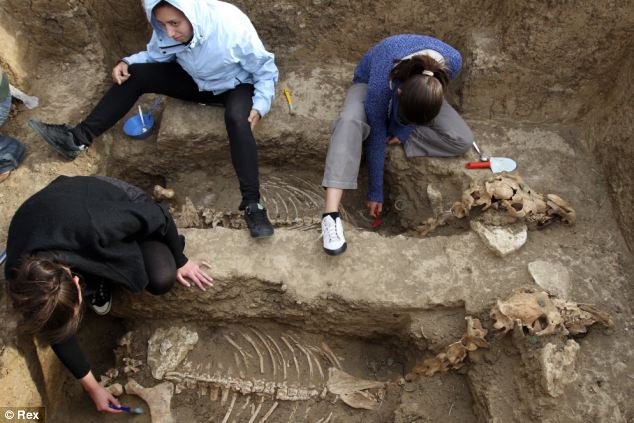
Archaeologists have uncovered the remains of a Thracian carriage and two horses that appear to have been buried upright.
The chariot and horse skeletons are 2,500-years-old and were discovered in the village of Svestari in north-east Bulgaria.
The two-wheeled carriage and carcasses of the horses were found in a Thracian tomb along with some decorations.
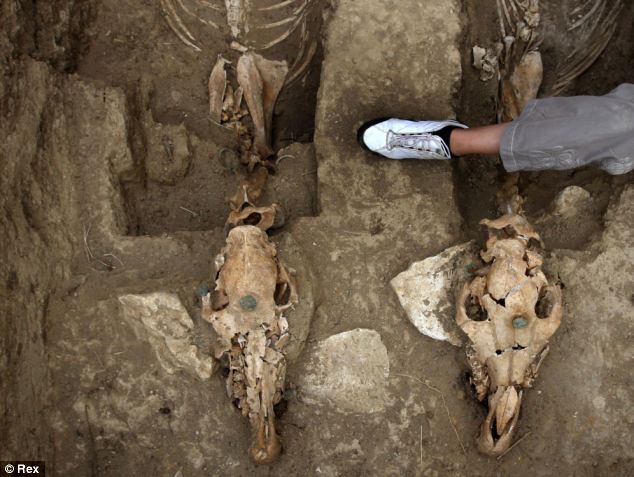
Professor Diana Gergova of the National Archaeology Institute at the Bulgarian Academy of Sciences, who led the dig, said: 'The find is unique, it is not resembling any other carriage dating from the Thracian era ever uncovered in Bulgaria.'
According to Sofia News Agency, the discovery of the carriage was unexpected as treasure hunters have plundered many of the ancient mounds found in the region in a bid to find gold, despite a UNESCO ban of this activity.
Particular mound where the carriage was discovered, is adjacent to the well known Mound of Bulgarian Khan Imurtag, where the same research team uncovered a hoard of gold last year...
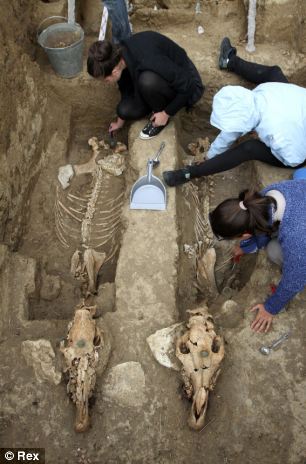
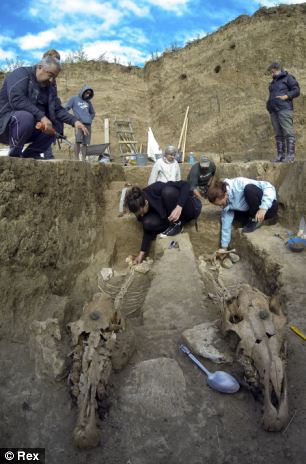
A Roman chariot complete with a seat and boot was unearthed along with two buried horses in the village of Borissvovo in Bulgaria in 2010, which shows similarities to the new find, despite being younger in age.
It was thought to belong to Thracian nobility living in the second half of the 1st century AD, judging by the imported goods found in nearby graves.
The burial mount yielded seven burial structures and two pits, one of which held the carriage and horses, HorseTalk revealed.

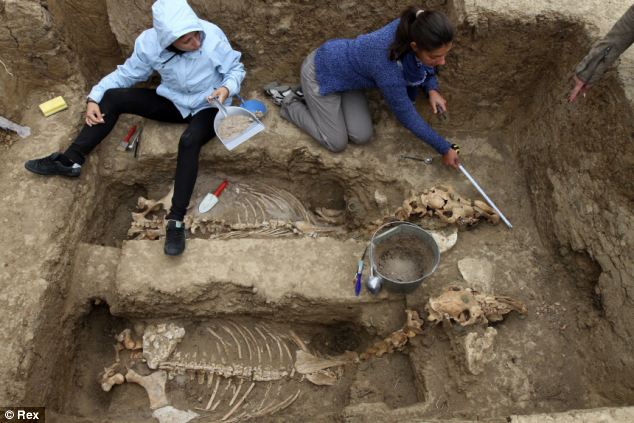
It is possible to see metal decorations (now discoloured green) that would probably have been on the horses' harnesses. This might suggest they were put into a narrow pit alive, pulling the carriage before they were killed
Experts believe the chariot was placed in a narrow hole with a sloping side to allow horses, decorated with elaborate harnesses, to pull it into its final resting place, after which they were killed.
The evidence of small metal disks on the horses' heads at the new sight, suggest they too were wearing harnesses.
The Borissovo chariot was supported by stones in order to keep it in its final position and offers researchers the chance to see how the vehicles were put together, including a 'boot' which held a bronze pan and ladle, grill and bottles.
A skeleton of a dog chained to the cart was also discovered, and nearby the grave of the warrior who is presumed to have owned the carriage, complete with his armour, spears and swords as well as medication and an inkwell, signifying he was well educated.
Archaeologist Veselin Ignatov, who was involved in the discoveryry of another the chariot near the southeastern village of Karanovo, said around 10,000 Thracian mounds - part of them covering monumental stone tombs - are scattered across the country.
Mr Ignatov said up to 90 per cent of the tombs in the region have been completely or partially destroyed by treasure hunters who smuggle the most precious objects abroad.
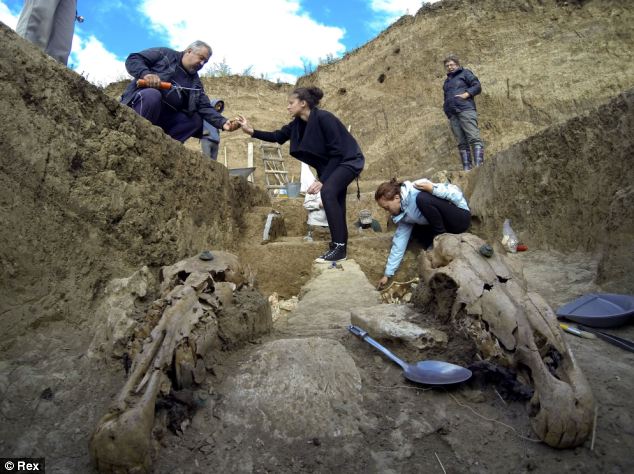
The two-wheeled carriage and carcasses of the horses (foreground) were found in a Thracian tomb along with some decorations
i wonder who is the raider of that..its Great Warrior i think..
Source : www.dailymail.co.uk...
Interesting find, probably better suited to the Ancient Civilization forum though.
I suppose the mystery is what this type of carriage was and why it was there, most likely something to do with the nobility.
Their religion has a nice conspiratorial slant to it.
After giving that a read I would like to throw out a quick guess at maybe it being some death ritual involving the Thracian Rider maybe ?
I suppose the mystery is what this type of carriage was and why it was there, most likely something to do with the nobility.
edit on 27-9-2013
by Tidnabnilims because: I'm not a historian but I play one on TV
Their religion has a nice conspiratorial slant to it.
After giving that a read I would like to throw out a quick guess at maybe it being some death ritual involving the Thracian Rider maybe ?
edit
on 27-9-2013 by Tidnabnilims because: Research and Speculation = Fun
The fact that this find is from Thracian origin is intriguing, it could have even been around during the time Spartacus led his troops during the
Third Servile War against the Romans way back in 73BC. Nice post Cheesy, star & flag for you!
Do they know whether these horses were buried alive, or were they dead, and burried with the carriage. Maybe they died during a battle, or some Noble
died during a trip with his/her horses and the carriage
Glassbender777
Do they know whether these horses were buried alive, or were they dead, and burried with the carriage. Maybe they died during a battle, or some Noble died during a trip with his/her horses and the carriage
Take a close look at the horses skulls, see the discolored spot on each skull? thats where the poleaxe hit each skull to kill the horse.
This might set the invention of the horse drawn carriage back another 1000-2000+ years!!
new topics
-
How To Spot Fake U.F.O. Photos
Aliens and UFOs: 5 hours ago -
Scary video of face in an abandoned house
Paranormal Studies: 7 hours ago -
Just Came Across These Unusual Old UFO Pics
Aliens and UFOs: 9 hours ago -
LA Mayor Bass Demanded $49M in Additional LAFD Cuts One Week Before Wildfires
Mainstream News: 11 hours ago
top topics
-
LA Mayor Bass Demanded $49M in Additional LAFD Cuts One Week Before Wildfires
Mainstream News: 11 hours ago, 17 flags -
Just Came Across These Unusual Old UFO Pics
Aliens and UFOs: 9 hours ago, 7 flags -
Scary video of face in an abandoned house
Paranormal Studies: 7 hours ago, 5 flags -
How To Spot Fake U.F.O. Photos
Aliens and UFOs: 5 hours ago, 4 flags -
Carry On!
Short Stories: 12 hours ago, 3 flags -
Sepultura - Territory - With New Drummer Greyson Nekrutman
Music: 12 hours ago, 2 flags
active topics
-
How To Spot Fake U.F.O. Photos
Aliens and UFOs • 3 • : Station27 -
Los Angeles brush fires latest: 2 blazes threaten structures, prompt evacuations
Mainstream News • 391 • : NoCorruptionAllowed -
Judge rules president-elect Donald Trump must be sentenced in 'hush money' trial
US Political Madness • 121 • : WeMustCare -
Candidate TRUMP Now Has Crazy Judge JUAN MERCHAN After Him - The Stormy Daniels Hush-Money Case.
Political Conspiracies • 2191 • : WeMustCare -
A Flash of Beauty: Bigfoot Revealed ( documentary )
Cryptozoology • 13 • : SteamyAmerican -
FBI Says IRAN is Trying to Kill Candidate TRUMP - But UKRAINE May Be a Greater Danger.
2024 Elections • 15 • : WeMustCare -
-@TH3WH17ERABB17- -Q- ---TIME TO SHOW THE WORLD--- -Part- --44--
Dissecting Disinformation • 3989 • : WeMustCare -
Old School Punk
Music • 566 • : underpass61 -
To become president, Zelensky had to learn Ukrainian
Political Conspiracies • 44 • : SteamyAmerican -
This should be plastered all over the airwaves
Mainstream News • 55 • : Astrocometus
18
